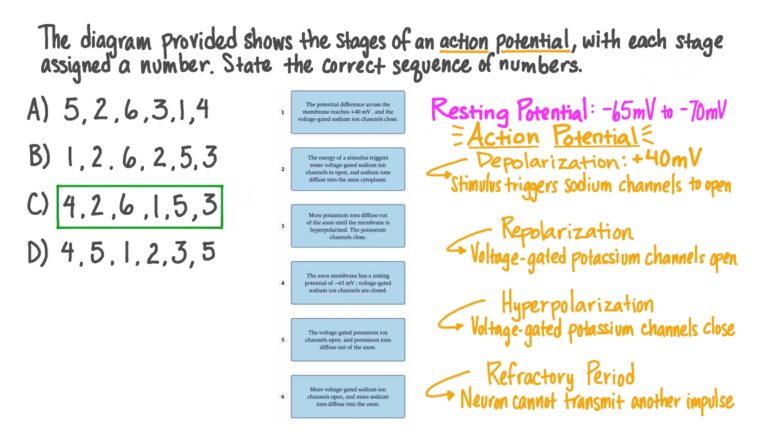Have you ever wondered about the intricate sequence of events that occur during an action potential in a neuron? Understanding the order of events in an action potential is crucial for grasping the fundamental concept of how nerve cells communicate. In this blog, we will unravel the mystery behind the sequence in which a neuron transmits signals. From the depolarization of the cell membrane to the repolarization and hyperpolarization phases, each step plays a vital role in the efficient transmission of electrical impulses. Join us as we dive into the world of neuroscience and explore the fascinating journey of an action potential.
Understanding the Basics of an Action Potential
An action potential is a vital physiological process that allows communication within the nervous system. It involves a sequence of events that enable neurons to transmit information through electrical signals. To grasp the concept effectively, it is crucial to delve into the fundamentals of an action potential.
The Resting Membrane Potential
At rest, a neuron maintains a resting membrane potential, typically around -70 millivolts. This is maintained by the unequal distribution of ions such as potassium and sodium across the cell membrane.
During this phase, the neuron is polarized, with a negative charge inside compared to the outside. This polarization sets the stage for generating an action potential.
Depolarization and Action Potential Initiation
When a neuron receives a stimulus, voltage-gated sodium channels open, allowing an influx of sodium ions into the cell. This influx results in depolarization, causing the interior of the neuron to become more positive.
This change in membrane potential triggers the initiation of an action potential, reaching the threshold for activation.
:max_bytes(150000):strip_icc()/human-brain--illustration-1161024046-0639c9749f8046e48893168f571440b5.jpg)
The Role of Ion Channels in Neuronal Signaling
Ion channels play a crucial role in neuronal signaling by regulating the flow of ions across the cell membrane. These channels are responsible for generating and propagating electrical signals, such as action potentials, in neurons.
The Functionality of Ion Channels
Ion channels open and close in response to specific stimuli, allowing ions to pass through the membrane. This process is essential for maintaining the resting membrane potential and triggering action potentials.
Regulation of ion channels is dynamic, with various factors influencing their activity, including membrane potential, neurotransmitters, and second messenger systems.
Importance in Action Potentials
During an action potential, ion channels sequentially open and close, leading to depolarization, repolarization, and hyperpolarization phases. This coordinated activity is vital for the transmission of neural signals.
- Sodium channels open first, allowing an influx of Na+ ions, triggering depolarization.
- Potassium channels open next, allowing K+ efflux, leading to repolarization.
- Calcium channels may also play a role in certain types of action potentials.
Initiation of the Action Potential: Depolarization Phase
During the depolarization phase of an action potential, the resting membrane potential of a neuron becomes less negative, typically reaching around -55mV. This depolarization is triggered by a rapid influx of sodium ions through voltage-gated sodium channels in the cell membrane.
Activation of Voltage-Gated Sodium Channels
As the neuron receives a stimulus, voltage-gated sodium channels open in response to the change in membrane potential. This allows sodium ions to rush into the cell, causing a rapid depolarization of the membrane.
This influx of sodium ions leads to a positive feedback loop, further opening sodium channels and propagating the depolarization wave along the neuron axon.
Role of Action Potential Threshold
The action potential threshold, typically around -55mV, is crucial for initiating the depolarization phase. Once this threshold is reached, the neuron fires an action potential, leading to the rapid depolarization and generation of an electrical impulse.
- Threshold potential reached
- Voltage-gated sodium channels open
- Sodium influx causes further depolarization
- Propagation of action potential along the neuron
Peak Potential: Repolarization Phase
Understanding the repolarization phase in an action potential is crucial in grasping the intricate sequence of events. After the peak potential is reached during the depolarization phase, repolarization occurs as the cell membrane potential returns to its resting state. This phase involves the efflux of potassium ions from the cell, leading to the restoration of the negative internal charge.
Importance of Repolarization
The repolarization phase is essential for the proper functioning of neurons and muscle cells. It allows the cell to reset and be ready for the next action potential. Restoration of the resting membrane potential is vital for maintaining the cell’s excitability.
Mechanism of Repolarization
During repolarization, voltage-gated potassium channels open, allowing the efflux of potassium ions from the cell. This outflow of positive ions helps in reestablishing the negative charge inside the cell. The balance between potassium efflux and sodium influx ensures proper repolarization.
Restoring the Resting Membrane Potential: Hyperpolarization Phase
After the action potential reaches its peak and the voltage-gated potassium channels open, there is a rapid efflux of potassium ions out of the neuron. This efflux results in the inside of the neuron becoming more negative than at the resting state, leading to hyperpolarization.
Activation of Potassium Channels
During the hyperpolarization phase, the voltage-gated potassium channels open, allowing an increased outward flow of potassium ions, which further decreases the membrane potential.
This stage ensures that the neuron’s membrane potential is restored to even lower levels than the resting state, preparing it for the next action potential. It helps in resetting the neuron for subsequent signaling events.
Role of Sodium-Potassium Pump
The sodium-potassium pump, a vital player in maintaining the resting membrane potential, becomes crucial during hyperpolarization. It actively transports sodium ions out of the cell while pumping potassium ions back in, contributing to the restoration of the original ionic concentration gradients.
- This active pumping mechanism helps in balancing the ion concentrations inside and outside the neuron.
Key Players: Sodium and Potassium Ions
When it comes to the order of events in an action potential, the key players are the sodium and potassium ions. These ions play a crucial role in the depolarization and repolarization of the cell membrane during an action potential.
The Role of Sodium Ions
Sodium ions play a vital role in the depolarization phase of an action potential. At the onset of the action potential, voltage-gated sodium channels open, allowing an influx of sodium ions into the cell.
This influx of sodium ions causes the cell membrane to become more positively charged, reaching its peak potential during the depolarization phase.
The Role of Potassium Ions
Potassium ions play a crucial role in the repolarization phase of an action potential. As the cell membrane reaches its peak positive charge, voltage-gated potassium channels open, allowing potassium ions to flow out of the cell.
This efflux of potassium ions helps restore the cell membrane to its resting potential, preparing it for the next action potential.
Importance of Action Potentials in Neurotransmission
Action potentials play a crucial role in the transmission of signals within the nervous system. They are rapid changes in the membrane potential of a neuron, allowing for the propagation of electrical signals along the axon.
Efficient Communication
Action potentials ensure swift and reliable communication between neurons, facilitating the transmission of information throughout the body efficiently.
Cell Signaling
Neurons encode and transmit information through action potentials, enabling complex processes such as sensation, movement, and cognition seamlessly.
Frequently Asked Questions
-
- What is an action potential?
- An action potential is a brief electrical impulse that travels down the axon of a neuron.
-
- What is the order of events in an action potential?
- The order of events in an action potential includes depolarization, repolarization, and hyperpolarization.
-
- What triggers the initiation of an action potential?
- The initiation of an action potential is triggered by a sudden change in the neuron’s membrane potential.
-
- How does an action potential propagate along the neuron?
- An action potential propagates along the neuron through a chain reaction of depolarization and repolarization of membrane potential.
-
- What role do ion channels play in an action potential?
- Ion channels are essential for the movement of ions that contribute to the changes in membrane potential during an action potential.
Unlocking the Mysteries of Action Potential: A Recap
As we conclude our exploration into the fascinating world of action potentials, we now have a clearer understanding of what is the order of events in an action potential. From the resting membrane potential to depolarization, repolarization, and hyperpolarization, each step plays a crucial role in the transmission of electrical signals along neurons.
By unraveling this intricate process, we have gained insights into how our nervous system functions and communicates. Understanding the order of events in an action potential not only deepens our knowledge of neuroscience but also enhances our appreciation for the wonders of the human body.
Remember, the journey of learning is continual, and the mysteries of science are ever-evolving. Stay curious, stay engaged, and keep exploring the marvels of action potentials and beyond!



